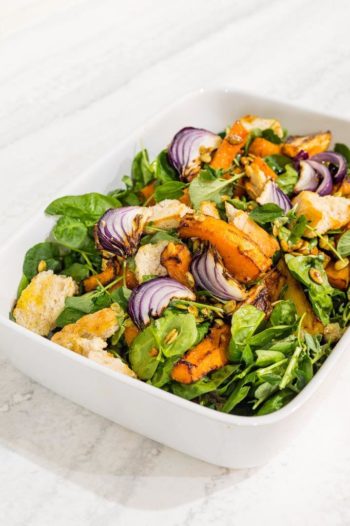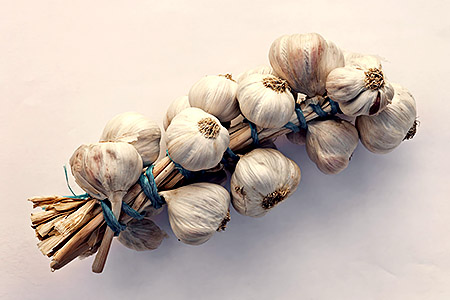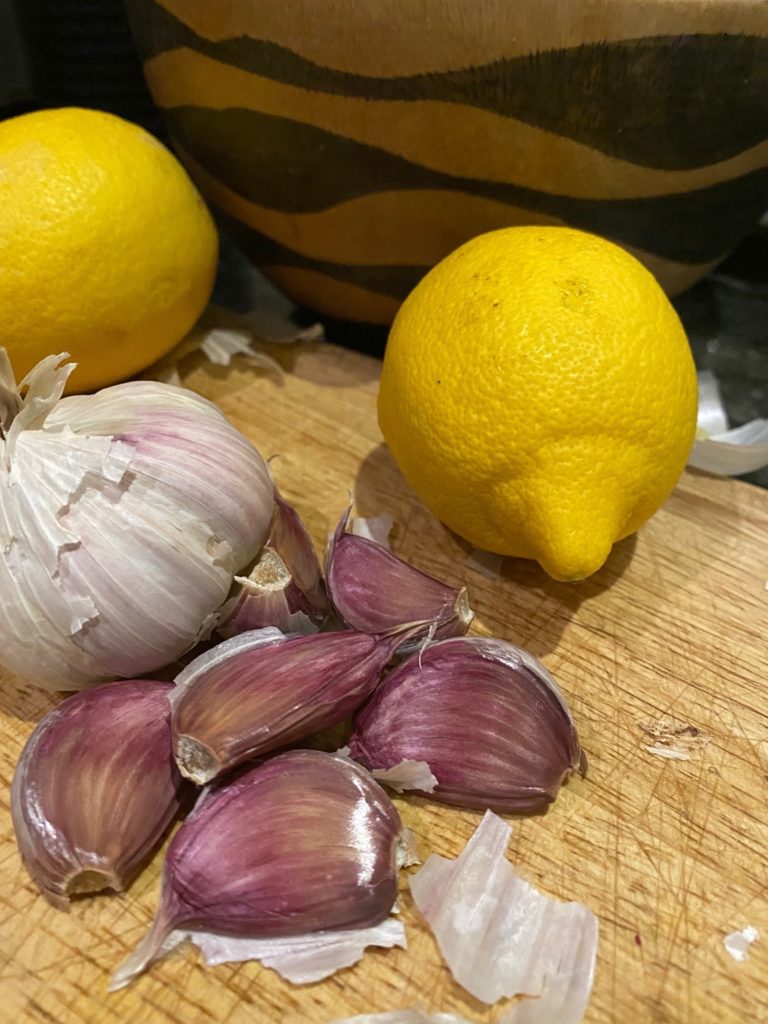
If you walk down the old staff stairs behind the green baize door in the corner of the saloon and turn into what used to be the staff dining room, today you will find the beginning of the Egyptian Exhibition. This explores the discovery of the tomb of Tutankhamun by Lord Carnarvon and Howard Carter nearly 100 years ago and winds its way through the old cellars using the atmospheric low ceiling heights and rough brick walls to great effect.
Half way through your journey, you step gingerly into a vaulted dark cellar which remains quite gloomy. It is kept dim and partially closed off to give an inkling of what it must have felt like to peer through a tiny gap into a shadowy and spectacular world not seen for three thousand years. However, for all the glitter of gold and larger artefacts in the tomb, there were also thousands of everyday objects which depicted the pharaoh’s everyday life, from music to hunting, clothes and regalia but also what he ate.
One of these foods was garlic, used for millennia not just as a flavouring but also as a medicinal treatment. The physician Hippocrates (460-370 BC), known today as “the father of Western medicine,” prescribed garlic for a wide range of conditions including respiratory problems, poor digestion and fatigue. It contains various of the B vitamins, calcium, iron , zinc and a whole load of other goodies which help fight bacteria and even possibly help to fight cancer and heart disease. In any case, like many of you, I make sure it is included in a lot of my cooking.
Many of the books I write don’t really fall into a single literary category and my latest, “Seasons at Highclere” is no different. I wanted to create a book which looked at the history of the landscape around Highclere, the imperatives which have driven its creation and our efforts to preserve and enhance it whilst producing food but which also included a collection of my favourite seasonal recipes. I was thinking about what boosts our health and makes us happy and sharing it through photographs, painterly words, stories and archives to draw you in.
Last winter was tough. The vaccines and boosters were not yet available and, like everyone, there was no way I wanted to catch covid. As a result, I became quite obsessed with making Toum, a traditional Lebanese garlic dish which my number six sister and her husband introduced me to. You can use it as a dip, , marinate chicken and lamb in it or even add it to a large dish of roasted vegetables.
I have made it in a number of different ways beginning with a pestle and mortar to break down the garlic and it is really a type of mayonnaise but without using an egg as the emulsifier. It can be thin or thick, though that is a slightly more delicate process to achieve.
You need a fresh garlic bulb, peeling the cloves and splitting each one to take out the sharp strand of green inside which makes the raw garlic more palatable. The sea salt adds flavour and friction.
The recipe from my book is set out below and it is the perfect thing to keep away all those January sniffles.
 Ingredients:
Ingredients:
.Half a bulb of fresh garlic (about 6 cloves) with the little green heart cut out and removed.
.A pinch of good sea salt.
.Juice of half a lemon.
.200 ml/6 ½ flu oz. of plain sunflower or rapeseed oil (not olive oil as it is too strong a flavour and will overpower the garlic).
Method
Traditionally a pestle and mortar and a lot of patience was used to break down the garlic with the salt but these days it is infinitely quicker to use a hand blender or food processor.
- Put the garlic and salt in a bowl and pulse in short bursts until finely minced, occasionally scraping down the sides of the bowl so all the garlic is caught.
- Add 1 teaspoon lemon juice and continue processing until a paste begins to form. Then add a second teaspoon lemon juice and process until completely smooth and slightly fluffy.
- Keep the blender running and slowly drizzle in the oil in a very thin stream, 1 table spoon at a time, followed by little lemon juice. Repeat with another tablespoon of oil and the remaining lemon juice. Continue the process, alternating the oil with a smidge of water, until all the oil has been incorporated. Transfer the toum to a jar and store in the fridge for up to 1 month.
Serve with flat bread, roasted vegetables, sourdough …








 Instagram
Instagram
Lady Carnarvon, wonderful story today and I do love garlic. I would like to say your book Seasons At Highclere came by post on Saturday. It truly is an incredible book. Your written word draws me into every corner of the Castle and grounds. The photography could not get any better. This book has it all. Without a doubt it is a must have! Perfect. Cheryl
Thank you
Good Morning Lady Carnarvon, Your writing always captivates the reader and transports us to Highclere in vibrant color. Thank You, Robert
Thank you!
You are so right
Do you plant one certain kind at Highclere or several varieties?
I like trying different ones – it is easy to grow and then to store
Thank you for sharing your findings! Will be looking into purchasing your book.
Below is the link to amazn to purchase my book.
https://amzn.to/3keTGEb (UK) https://amzn.to/2VSUoyK (USA)
Lady Carnarvon lovely pictures of Garlic and did you and lord Carnarvon have a nice weekend and lovely to visit highcelere castle
I just tried black garlic and it does have a slightly different taste! It was delicious.
Wonderful!
Dear Lady Carnarvon,
fascinating recipe, I will give that one a try! Makes me think of summer BBQ’s, a nice addition to a lamb burger. I had no idea of the health benefits, except that if I have garlic, hubby must have it too, so that we are immune from each other. The landscape looks heavenly.
Jane
We so hope to visit in the future…Stay well.
I look forward to greeting you soon
My email was in error.
Good day again Lady Carnarvon,
Yes, the Egyptian Exhibition in the Castles former staff level is beautifully displayed. As a fan of Egyptian history and art I was fascinated to be able to take in the exhibition there during past tours given the history of Lord Carnarvons great grandfather and his relationship with Howard Carter.
When I did have my home in CT with my gardens I grew garlic along with other herbs and vegetables. You are so correct in all the benefits it can provide. Without gardens now I am always searching for fresh grown garlic to keep taking advantage of it’s benefits. Thank you for including the recipe for your Blog family to benefit from that aren’t fortunate enough to have your lovely Seasons at Highclere book, which is wonderful to read and see all the lovely photos. Congratulations on another successful publication!
Thank you
Ah, skordalia! Well, yes, Lebanese Toum is a close cousin, and we really do use Greek olive oil as Greek garlic is maybe very strong in flavor? Thank you for the Egyptian tale, I so remember my visit to the “downstairs” exhibit at Highclere. Your recipe, and all the recipes in your “Seasons at Highclere” are excellent, along with the beautiful photographs and stories, too. I only wish “Seasons” was the same large size and format as “Entertaining”, as the text in “Seasons” is a bit too small for my ol’ eyes. Maybe the publishers will enlarge the size a bit for a second edition? Still, “Seasons” is a most excellent volume of sights and sounds, tastes and aromas at Highclere!
We do love garlic and I incorporate it as much as possible. This sounds wonderful and will definitely give it a go. Thank you for the history lesson. Of the thousands of amazing facts we gleaned while in Egypt on a Viking cruise January 2020, we didn’t hear about their use of garlic.
Dear Lady Carnarvon,
I was gifted your beautiful book at Christmas from my daughter. She and I had the wonderful pleasure of visiting Highclere in 2014, and it was a very special trip.
“Seasons at Highclere” is a magical book filled with wondrous recipes, stories and photographs. Garlic is a prominent wholesome ingredient on many levels, and we see that for thousands of years it has been a healthy choice!
I love your recipes as they are delicious, elegant, beautiful and creative. This healthy addition is at the ready!
Please continue to take good care, and many thanks for your wonderful Monday posts!
Best regards,
Charlotte Merriam Cole
Good morning Lady Carnarvon-
Thank you for another wonderful start to my Monday – Martin Luther King Day here in USA.
I see you have 17 previous blog entries that talk more about the collection of items from tomb of Tutankhamun. Do any of those 17 give information about how it came to be that all those items were taken from Egypt? I’d like to learn more. Guess I should just read all 17. 🙂
Your garlic reminded me of a story. When I was a new young wife, I loved to cook but had never cooked with garlic. I found a dish to try that called for a clove of garlic. Being inexperienced, I thought the whole bulb was a clove. Needless to say, the house and our pores reeked of garlic after making and eating the dish. That started our love for the taste of garlic. Thanks for the delightful column and the memory.
Your photos are also beautiful!
Very funny story!
Lady Carnarvon,
Thank you for the amazing story and recipe, they were both greatly appreciated. I do quite a bit of canning and preserving so I look forward to trying this recipe out . Seasons at Highclere is next on my list of books to purchase ! -Janel West
Good Morning from Virginia!
Having lived in Egypt for 26 years, I not only visited the original King Tut exhibit many times (and also enjoyed the Highclere exhibit 5 years ago) but learned to cook and bake most local dishes. The one you describe is called “Tomheya” in Alexandria and we made it often. Some folks add a bit of boiled potato to thicken the mixture. It is delicious and I am so happy to see you bring it to your page. I enjoy your weekly blog and thank you for the entertaining and informative dialogue!
Stay safe and well,
Diane
Thank you
Thank you for the recipe I will certainly try it.
Has the Egyptian government ever requested that the artifacts be returned, I often try to think how British people would feel is someone came to our country and removed artifacts that we hold dear. A know it was a different time but colonial mistakes should be corrected don’t you think?
Thanks for your blog I really enjoy your writing. Maxine TO Canada
Your words have inspired me to try my hand growing garlic in my own little garden. I am excited to try your recipe. Thank you as always for your beautiful blog I look forward to it!
Sea salt is much better than table salt. It has naturally occurring Iodine, Magnesium and other minerals. Garlic is very good for the cardiovascular system. I like your recipe. Could a touch of cummin powder work with this?
Amazing Recipe, I’ll have to try that!
Let me know what you think!
Good morning from Fort Worth, Texas! My husband and I add garlic to most of our food. Alas, since we both are required to wear masks due to health conditions, it became quickly obvious that recycled garlic breath isn’t very pleasant. However, my husband is a retired physician and has long been aware of the unique healing properties of garlic, so we put up with it.
Well done!
Thank you so much for this story.
I also love garlic and will indeed try your recipe.
Best regards
Kathleen from Canada
What a great read this morning with my coffee on a snowy winter’s day. Really enjoyed it. Cheers from Columbus, Ohio!
Highclere is frosty but luckily no snow!
I love this blog too – Nora from Columbus, Ohio. I am London now for the Christmas season but have previously visited Highclere. Have you?? It is magnificent!
Lady Carnarvon lovely pictures of Garlic and did you and lord Carnarvon have a nice weekend and lovely to visit highcelere castle
Thank you for sharing. yet another wonderful story. I also grow garlic in the South of the US. I’m always looking for new ways to use my bounty (of course after sharing). This is now on my menu for tonight with chicken. The information about King Tut’s tomb was very interesting. I can only imagine how exciting the discovery was felt around the world. Once again my Monday morning has begun with a new inspiration. A history lesson and a new recipe. What a great start to my day!
Fabulous!
Nice pictures! It is clear that you spend a lot of time on these blogs every Monday, I hope you will continue to do so forever.
Thank you!
This recipe is like a garlic pesto, many possibilities! Yum and thank you. I look forward to your weekly blog on Mondays! It provides a tasty bit of humor with tradition and civility in this post COVID world. Thank you so so much for taking the time to include us in the world of Highclere Castle. It means so much to many of us. I truly believe that Highclere and Downton Abbey are in the “ether” and the collective conscience now. Is the 100 year anniversary of the Tutankhamun discovery by Carter and Lord Carnarvon coming this November of 2022? Amazing…
I can’t tell you how much Highclere and Downton Abbey helped us through 2020 and 2021. Especially 2020. Every few weeks or so in 2020 we’d place an order with the gift shop and wait in great anticipation for the delivery. Unpacking the goodies was so much fun, love the beautiful blue tissue paper all the items were so carefully packed in as well. We had so much fun giving many items away to friends and family who also love Downton and Highclere. Sally Popplewell is amazing by the way. One time we received a package that had been shipped in a cardboard Highclere Gin box!! I can’t tell you how over the moon we were about that. We can’t get the gin or food stuffs because of the rules and regs. as you know. We still have the gin box and bring it out at Christmas, put a big red bow on it and place it under the Christmas tree close to the Highclere ornaments.
We can hardly wait to come and visit Highclere Castle someday very soon. Walk the grounds and see the legacy of Capability Brown, have some tea and purchase some of that Highclere gin in person!!
I will inform Sally Popplewell you think she is amazing!
Dear Lady Carnarvon,
The timing of this story comes just after we have enjoyed the episode on PBS with you and Mary Berry! It was MARVELOUS! How sweet to see you two conversing, cooking, laughing, exploring the hillside for WWII plane parts and having tea together, culminating in the lovely dinner party! Truly I do not say this to flatter you, but your warmth, caring and gracious manner shows in all you do. Highclere could not possibly have better caretakers than you and Lord Carnarvon. God bless you both.
P.S. Regarding garlic, we are in full agreement with you and also consume our wonderful Sweet Vidalia and Texas onions with great enthusiasm!!
Blessings,
Gay Hightower
Atlanta, Georgia
Thank you
I love garlic and when a recipe asks for one clove, I usually put six in! My husband cones into the kitchen and says, “cooking with a little bit of garlic, are we?” I will certainly try your recipe!
We have friends that are garlic lovers as well. When they go on holiday, they eat a lot of garlic they even feed it to their dog so that they all will have smelly breath!
Carolyn Dear
Montreal, Canada
How funny!
Dear Lady Carnarvon
Your Blog was most fascinating not only for the subject Garlic, but the introduction to the King
Tutankhamen exhibit. I do hope you will be writing the Book on the 100th Anniversary of the
Tomb’s opening.
Yup I am !!!
Lady Carnarvon,
A little late in responding to this morning’s post, but pleased as usual to read your thoughts. I especially liked “I was thinking about what boosts our health and makes us happy and sharing it through photographs, painterly words, stories and archives to draw you in.” Thank you for that ‘mind picture!’
Neither hubby nor I are fan of garlic, but realize its medicinal values, so are pleased when it’s frequently incorporated into foods here at our retirement home where the food is generally delicious.
We were amazed by the Egyptian collection when we visited in 2013. I am thankful that preserving history was and still is uppermost at Highclere – from ancient Egypt to current conservation of the land for posterity.
Thank you for another lovely morning read as we remember Dr. Martin Luther King, Jr. and his words, “Life’s most persistent and urgent question is, ‘What are you doing for others?’ “ Highclere certainly lives up to that statement.
Martha G.
You are kind – thank you Martha
That recipe sounds delicious and I’m going to give it a try — thank you for sharing it!
It is – I made it yesterday and it is a little yellow as used rapeseed oil – but have already enjoyed it and I am not sure it will last long in my fridge!
What a coincidence it is for me to see an image of Egypt in this post. We just returned from there (you may be happy to know it was with Viking!), and we visited Tutankhamun’s tomb in the Valley of the Kings. Of course, I thought of Highclere and our visit in 2019, including your Egyptian exhibit. We tested positive for Covid upon arrival in Jordan after 11 days in Egypt and had to quarantine for 6 days at a hotel in Amman. We felt pretty good and we were treated well. When we tested negative, we went out to a fantastic Jordanian restaurant for dinner on our last night in Jordan. Your recipe reminds me of some of what we had there. I will have to try to make Toum sometime. I hope all is well with you and yours.
That sounds great and I am working with viking for journeys on their boats on the Nile…
I’ve really enjoyed your presentations with Viking.tv during this time… I hope you will keep making these interesting and informative bits of about Highclere Castle and your families’ history!
Thank you – they are great company to work and one I admire so I hope so!
Garlic is the best!
Agreed
Greetings: I have always been interested in Egyptology especially the history and details surrounding the discovery of Tutankhamun’s tomb. I have visited the tomb in the Valley of the Kings and viewed the tomb artefacts at the Cairo Museum and elsewhere when they went on tour. Have you ever had an exhibition of the artefacts at the house…especially the throne and the gold mask? Cheers ..enjoy the blog..always fascinating and I appreciate your attention to detail in every article. I especially enjoyed the articles detailing preparation for Christmas at the house. Thank-you
Thank you! I have looked upon the iconic mask but it is far better off in Cairo, in its home!
LADY CARNARVON,
Thanks for sharing, my daughter always says when someone ask, is there enough garlic in it & she says there is never enough lol
Love the photos,
Barbara Bouchard
Oh, I love garlic. One of the most important ingredient in Romanian cuisine, especially in Transylvania area( great for immune system and good protection in case of Dracula’s visit…). We call it ” mujdei de usturoi” and I love to use it with sour cream/ yogurt and mayonnaise and a good bunch of chopped parsley leaves.
Love your post, as always.
Have a wonderful day!
Greetings from Cluj-Napoca, Romania,
Diana
You too have a wonderful day!
Dear Lady Carnarvon
Lovely post and I remember the Egyptian exhibit well. The design was excellent, actually better than the old Egyptian museum which didn’t use lighting to good effect.
Thank you for your ‘garlic’ blog and yes it definitely has medicinal properties. I’ve added a clove to my chickens water container when I suspected one was ailing. Good healthy rare breeds…nothing like the old remedies!
Stay safe and well and hope to visit again soon.
Best regards
Lady Carnarvon,
Thanks for the amazing insight into the Egyptian exhibition at Highclere. Always fascinating. I love your garlic recipe and so does my family. My paternal family would like it too; as they are Lebanese descendants.
Sounds Lovely! I must make this once my Meyer Lemon ripens! Thank you!
Dear Lady Carnarvon,
Would you please share how you produced the infrared film effect for your initial photo?
My understanding is that you use the camera on your phone (which inspired me to acquire an Apple Pro for my own Christmas present), so “no film,” per se.
Does the effect come afterwards from applying filters to the “printed” image?
The foreground could be lushly flowering white azaleas or rhododendrons, but the trees in the mid- and background suggest infrared or a filter.
Best wishes from Northern Virginia, where the snow makes its own infrared-like visual.
It was with the help of our graphic lady here – teh guardian statue photo is portrait and from our own exhibition and I asked her help to create something more landscape!I thought it was lovely
Garlic plays a very large part in my daily vitamin regime for no only the wonderful taste but the health benefits for cholesterol and blood pressure. When my blood pressure was creeping up about 15 years ago, I asked my doctor to give me 6 months and by adding loads of garlic, I am happily back to normal. I am enjoying your blog and updates and look forward to reading more during these still dark times we find ourselves in.
And I have just had some toum!
Dear Lady Caernarvon,
I have been so interested reading your article on Garlic. I am a great believer and user of Garlic
as a universal healer. My family and I live in Chester, where I was born, and there is an old house
in the city centre known as God’s Providence House. It was a Merchant’s House and it was so named,
because it was the only residence in the city, where no one in the family became ill or died during a
plague. This was thought to be because of the presence of garlic stored in the cellar which the family
used for cooking and medicinal purposes.
My son, knowing how much I enjoy your books, bought me Seasons at Highclere for Christmas
and I absolutely love it.
I am so looking forward to visting Highclere in the not too distant future.
I look forward to greeting you soon!
As an herbalist and medicinal farmer, i am thrilled to see this post and recipe! I always enjoy your writing so much too. Thanks for sharing all the way to Northern Michigan USA!
How very kind – thank you
Dear Lady Carnarvon,
I always learn something new from your Monday Mornings! I had no idea garlic had such a long history. I love to smell minced garlic cooking in butter. However, I have been on the dining end of a “chef” who was unclear of the terms clove vs knob and it was a potent dining experience.
You’ll laugh, when I saw rapeseed oil I thought the “g” was missing. After the second time, I decided to Google the oil and voila there it was. I’ve never heard of this oil. My go to oil is extra light olive oil.
When I was in 5th grade we studied Africa. Coincidentally, the King “Tut” exhibit was at the National Gallery of Art, in Washington, DC and our class was taken on a field trip to view the artifacts. My mind has held on to the image of the smallest pair of white gloves.
I hope you have a wonderful week. I love your photo of the serene frosted landscape. It’s bitterly cold (20F) in Virginia, today.
Cheers until next Monday,
Shelley
MY DEAR LADY FIONA,
GOOD EVENING MILADY,
VERY WARM DAY IN RIO CLARO, 35 °CELSIUS. 12H56M
MY SPANISH GRANDFATHER LOVED TO EAT RAW GARLIC WITH A DRIZZLE OF EXTRA VIRGIN OIL IN HOMEMADE BREAD AND I LEARNERD TO LIKE ONIONS ,GARLIC AND GINGER FROM A YOUNG AGE.
THANK YOU VERY MUCH FOR YOURS POST . AMAZING. YOURS BOOKS TOO.
VILA ALEMÃ
RIO CLARO – SP
BRAZIL
Dear Lady Carnarvon:
Thank you for this past Monday’s blog.
I know that you have written about King Tut’s tomb and exhibit at the Castle in previous blogs, but I enjoyed reading the history presented here.
Also, thank you for sharing the recipe for Toum. Is your Season’s at Highclere” book available in a digital format? If so, what is the link to obtain the same?
Until next week, happy cooking.
Perpetua Crawford
How lovely is your column! By the way, I also love garlic and I´m planning to buy the black garlic. I heard it is delicious. I enjoy reading your emails every week and never erase it so I can go back and read it again. What a treat. Thank you for making me a part of your world.
Thank you!
Dear Lady Carnarvon,
Thank you for this post. I do love reading your blog every Monday! My love of Highclere Castle, like so many others, began within the first few moments of watching Downton Abbey. However, my interest has expanded over the years, after learning more about your family’s connection to King Tutankhamun and the link between the 5th Earl of Carnarvon and, who appears to be a distant cousin of mine, Arthur C. Mace. After years of genealogy research, on multiple branches of my family tree, I believe I am related to Arthur who is best known for his work with Howard Carter in the excavation Tutankhamun’s tomb. As I understand, Lord Carnarvon spent a significant amount of time with Carter and Mace in Egypt, but unfortunately passed away before Arthur was able to visit your family at Highclere, as per the reference in the book about A.C. Mace’s life, “…the grand piano came by camel”, authored by Christopher Lee.
I am thrilled, due to a work conference, to be able to travel from Canada to England this May and hope to take part in your Living in a Castle tour on May 13th. While I do not believe the Egyptian Exhibition is part of this event, I am interested to learn if there are any documents in your collection that may pertain to Arthur Mace and his work supporting the excavation of the tomb?
Thank you in advance for any information you can provide. It will be thrilling to see your incredible home in-person!
Sincerely,
Lisa
What a great link – thank you!